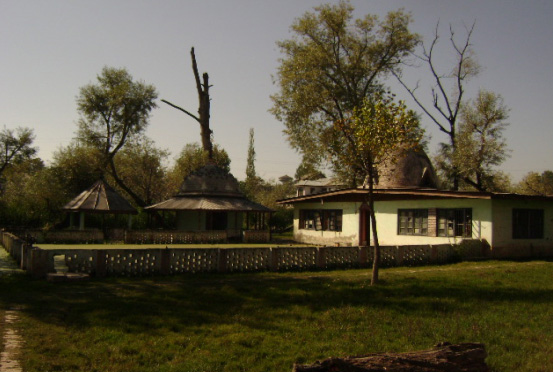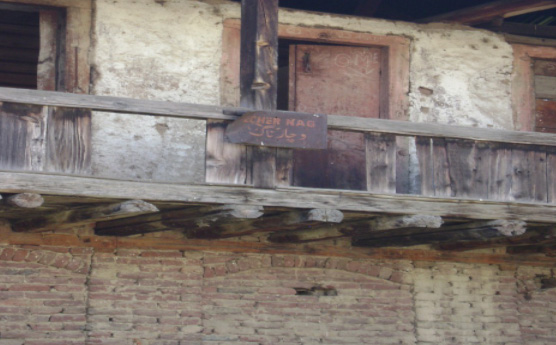Vichar Nag Temple
The Seat of Discussion and Thought
by Chander M. Bhat
“Destroyed is my delusion as I have gained my knowledge through thy grace, “O”
Krishana. I am now freed from all doubts. I will act according to my word;
promised Arjuna after listening to wonderful recitals from Yogeshwar. This
thought or Vichar of Kesva transformed a non act into decisive action. The
recitals of this sacred thought are now blood in the veins of Sanatan Dharma.”

Shiva watching the remains of the Eternal Spring
Beating the dreams of thought in the heart of
the land of Kashyapa, the blissful Vichar Nag gained popularity due to, it,
being the seat of discussion and presentation of thought for learned Kashmiri
ethos for settlement of disputes of Panchang, Mahurats and religious
reformations.
Vichar Nag is situated on Srinagar-Leh highway at a distance about 9 km from
commercial centre of Kashmir, Lal Chowk. On Chaitra Amavasiya, the last day of
Kashmiri calendar, a festival is celebrated at this place. Legendary Shri Bhat,
the bane of transformation of Sultan Zainulabidin ‘Badshah’ hailed from this
area.

My heart is bleeding seeing the people ignoring me
Vichar Nag is in the heartland of Naushara
locality of outer Srinagar. Famous Anchar Lake is adjacent to this monumental
pride of ancient Kashmir. Vichar Nag has also a historical place on its east
known as Awanta Bhawan dating its origin to king Meghwahana and this place finds
its traces in Kalhan Pandits Rajtarangni as built by Meghwahans wife Queen
Amrita Prabha.
Vichar Nag is famous for its spring and two age old Shiva temples. One temple is
made of chisled and dressed devri stones. There is a necklace of springs but the
locket is the big spring which is a centre of attraction and sanctity. The
spring has a length of 430 feet and breadth of 35 feet. Big sized ‘Devri’ stones
have been used for construction of stairs to the spring on West and South side.
There is no access on north and east side probably to face the morning glory of
the Sun.
The spring has a boundary walling of stones and the images of some Devi, Devtas
are inscribed on them. In the middle of the spring there is a stone cylinder of
about 3 feet height and a Shivalingam is resting on it. On one corner, the water
gushes out from a small outlet and fills the other springs. From there the water
comes out in the shape of a small brook and joins the outlet brook of ‘Mukhta
Pukhri’ spring. After covering a sizeable distance it flows into Lake Anchar.
The spring water contains different verities of fish. The water turns ice cold
in summer and lukewarm in winter. It is held that this spring changes its colour
from time to time and images of any blackish colour are held as most
in-auspicious.
In the vicinity of Vichar Nag, there are many springs and water of some of the
springs has clinical value as it is useful in treatment of some skin diseases.
Vichar Nag had a number of willow trees in its surrounding and now only few of
them can be traced. Even Kalhan Pandit had mentioned existence of walnut trees
in Vichar Nag and mentioned about the simplicity of Kashmiri Pandits living in
and around this temple.
Vichar Nag was seat of thought and Kashmiri Brahmins used to discuss Panchang
over here. It is believed that one learned Kashmiri Brahmin Sh. Vasdev’s
‘almnac’ was once held as incorrect by some other Brahmins. After discussion at
this place, the work of Sh. Vasdev Pandit was found correct.
On Chaitra Amavasiya, the last day of Kashmiri calendar, a festival is
celebrated at this place. On this day devotees take a bath in the holy spring
and there after performed puja in the Shiva Temple known as ‘Vichar Saheb’. It
is believed that 4th Buddhist council, which was held in Kashmir also, was held
at Vichar Nag. Vichar Nag was a transit spot for pilgrims of Kshir Bhawani,
Tullamulla and Gangabal as scarce transport facilities did not allow continuous
journey.
Before the displacement of Kashmiri Pandits from the valley, the management of
this holy shrine was in the hands of trust Asthapan Vichar Nag.
Would now some body come and see from the erstwhile managers that the Vichar Nag
spring is now an abode of water plants with a green top rest hiding clear
crystal water and Vichar Saheb seeing dogs; resting in his place, where he used
to see Dhoop, Agarbaties, Bel leaves and flower petals from devote Kashmir’s,
would the trust or Government authorities wake up and see Dharmshalla with
hallowed doors and windows? Would any body from authority raise his hand and
bring back the glory and legacy of Vichar Nag? Hey if we don’t care, we will
loose this great inheritance to encroachment and time. Remember Vichar Nag was a
place where time was decided and now time should not be allowed to decide it.
Image
Gallery: http://ikashmir.net/gallery/categories.php?cat_id=230
| 